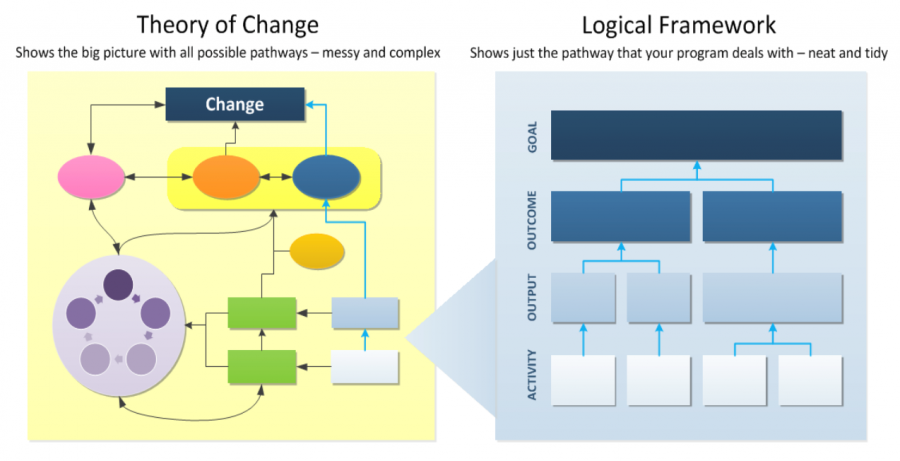I think often about the importance of curiosity and a playful approach to evaluation. This is especially true at camp, where we are quite literally in the business of play. And it is also true with evaluation — despite its scientific veneer, evaluation is fundamentally about people and their stories. In this blog, I’m going to ask you to be curious with me as we play with logic models, one of my favorite evaluation tools.
Logic models were always a hit with the undergraduate students I used to teach, primarily because they appeared simple and straightforward (i.e., they did not require writing a lengthy paper). They especially liked the colors, and the boxes, and how everything fit neatly on one page.
Ha! I would say, logic models are anything but simple or straightforward. They are complex, and dynamic, and less about the boxes than the arrows that connect them. The arrows are the most important part of the logic model — the graphic representation of linkages between inputs, activities, outputs, and outcomes. Without arrows, we just have boxes; with arrows, the things in one box produce the things in the next and so on. It’s all about the arrows, I’d harp, and the students would dutifully add their arrows.
But not until recently did I realize that I couldn’t say much about the arrows, other than that they connected the boxes. What happened was someone asked about the difference between a logic model and a theory of change. They are often used interchangeably, which made the question a good one — and one I thought I could answer easily.
A logic model, I said, is a road map leading from inputs to activities to outputs to outcomes (for more on logic models, check out Lisa Westrich’s excellent crash course, or an example shared with us by Katie Wheatley from Tim Hortons Foundation Camps, or some ways we are using logic models to think about evaluating virtual camp programs and about research in the age of COVID-19).
Theory of change is just that — a theory; a theory of how your program works and why. A theory of change is a logic model that has been tested, refined, and tested again, repeatedly, over time, until it is robust enough to be applied in other ways, or to predict what will happen if certain parts of the logic model are changed. Like a well-worn pair of shoes that you know inside and out and trust will hold up on trails as much as the sidewalk, in good times and in bad.
So, this person asked, a theory of change is what allows us to understand the arrows, right?
Just as I was about to give a confident yes, I thought, better look that up. Glad I did, too, because I was only sort of correct — and also sort of missing some important connections between logic models and theory of change.
Piroska Bisits Bullen depicts in Theory of Change vs Logical Framework – What’s the Difference? how a logic model (here, “logical framework”) can actually be a small part of a much more expansive theory of change.

Others describe logic models as program-specific while a theory of change depicts and entire organization, or, similarly, the logic model depicts the detail while the theory of change takes the high-level view. And unlike a logic model, which most typically includes inputs-activities-outputs-outcomes in some box-and-arrow format, theory of change does not have a specific format; in fact, it might not be linear or even visibly logical.
Why? Because arrows, of course. Like in a logic model, arrows are used in theory of change to show linkages; however, the arrows in this case are baked with meaning. Arrows, in a theory of change model, represent the conditions, assumptions, and evidence that allow us to connect one thing to another. In general, conditions = external factors or trends that you do not control (but affect your program), assumptions = truths or beliefs that are always worth examining, and evidence might be information you’ve gathered over time that suggests how one thing is connected to another.
Bottom line:
- Logic models and theory of change are related but different; friends who look alike but really have their own unique function and purposes
- Both are fundamentally about arrows, but a theory of change demands a deeper understanding of these linkages and why they exist
- Neither are useful if they are not allowed to live and breathe and grow and change over time.
Which is to say, this all sparked even more curiosity for me — curiosity about logic models and theory of change and what lies in between and across these more dominant models. In future Research 360 blogs, we will continue to play with the logic model and different ways we can depict and evaluate change through camp experiences.
In the meantime, happy evaluating!
Laurie Browne, PhD, is the director of research at ACA. She specializes in ACA's Youth Outcomes Battery and supporting camps in their research and evaluation efforts. Prior to joining ACA, Laurie was an assistant professor in the Department of Recreation, Hospitality, and Parks Management at California State University-Chico. Laurie received her PhD from the University of Utah, where she studied youth development and research methods.
Thanks to our research partner, Redwoods.
Additional thanks goes to our research supporter, Chaco.
The views and opinions expressed by contributors are their own and do not necessarily reflect the views of the American Camp Association or ACA employees.





